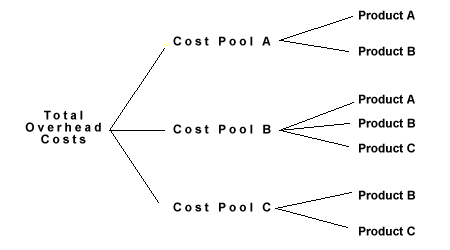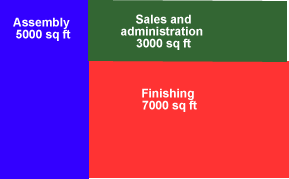focuses on Process Costing. There are two main types of cost accounting
systems. Companies select a method that best matches the flow of work in their
business. These methods are used to allocate all production costs: labor,
materials and overhead.
| Job order costing - work is broken into jobs;
each job is tracked separately |
auto mechanics, carpenters, painters, print shops, computer repair |
| Process costing - a large quantity of identical
or similar products are mass produced |
auto assembly plants, hot dog manufacturing, any large mechanized
production facility |
Each cost accounting system gathers and reports on the same information. The
method used depends on the needs of the business.
Process Costing traces and accumulates direct costs, and allocates
indirect costs, through a manufacturing process. Costs are assigned to products,
usually in a large batch, which might include an entire month's production.
Eventually, costs have to be allocated to individual units of product.
Why do we need to allocate total product costs to units of product?
A company may manufacture thousands or millions of units of product in a given
period of time.
- products are manufactured in large quantities, but,
- products must be sold in small quantities, sometimes one at a
time (automobiles, loaves of bread), a dozen or two at a time (eggs,
cookies), etc.
- product costs must be transferred from Finished Goods to Cost of
Goods Sold as sales are made. This requires a correct and accurate
accounting of product costs per unit, to have a proper matching of product
costs against related sales revenue.
- managers need to maintain cost control over the manufacturing
process. Process costing provides managers with feedback that can be used to
compare similar product costs from one month to the next, keeping costs in
line with projected manufacturing budgets.
- a fraction-of-a-cent cost change can represent a large dollar change
in overall profitability, when selling millions of units of product a month.
Managers must carefully watch per unit costs on a daily basis through the
production process, while at the same time dealing with materials and output
in huge quantities.
Allocating Overhead using ABC Costing
Overhead is a large mixed group of costs that can't be directly traced to
products. There are several methods of allocating overhead costs in a
cost accounting system. ABC costing is one method. We will learn other, simpler
methods as well.
| Activity-based costing (ABC) - overhead costs are
tracked activities that consume resources |
used primarily for allocating overhead that is hard to track to
specific products or departments |
ABC Costing is a little more sophistocated that the single-driver method
covered in Chapter 17. But it is really not much more difficult. ABC Costing
assumes that
- you may have more than one cost driver that is relevant,
- a single cost driver may incorrectly allocate costs to products or
departments -- too much or too little costs, or costs allocated to the wrong
department or product,
- service type enterprises don't produce a product, but must find a way to
allocate overhead costs to services provided (e.g. hospitals),
- multi-department and multi-factory situations require more sophistocated
overhead allocation methods.
Two-Stage Overhead Allocation
| Stage 1 |
Stage 2 |
| Allocate Total Costs to Pools |
Allocate Pools to Products or Services |
Nagle Manufacturing has identified 3 cost pools, each with a relevant driver.
They can trace total overhead costs as follows.

Using separate cost pools and drivers, Nagle Manufacturing can allocate total
overhead costs more accurately to the products that consume those costs.
EXAMPLE - Occupancy Cost Pool allocation
 Mike's
Bikes, Inc. decides to allocate factory Occupancy costs based on the square
footage each department occupies. Occupancy costs include many common costs,
like heat, air conditioning, water & sewer, lights, cleaning and maintenance,
insurance, security and other related costs.
Mike's
Bikes, Inc. decides to allocate factory Occupancy costs based on the square
footage each department occupies. Occupancy costs include many common costs,
like heat, air conditioning, water & sewer, lights, cleaning and maintenance,
insurance, security and other related costs.
The company draws up a floor plan and measures how many square feet each
department uses.

They had a total of $120,000 in Occupancy costs last year.
The company produced 6000 bicycles last year
Occupancy Cost Pool Overhead Allocation
| Department |
Sq ft
|
Cost allocation formula |
Allocated
to depts |
Bicycles
made |
Overhead
Per Bike |
| Assembly |
5,000
|
/ 15,000 * $120,000 = |
$40,000
|
/ 6000 = |
$ 6.67
|
| Finishing |
7,000
|
/ 15,000 * $120,000 = |
56,000
|
/ 6000 = |
9.33
|
| Sales & admin |
3,000
|
/ 15,000 * $120,000 = |
24,000
|
/ 6000 = |
4.00
|
| Total |
15,000
|
|
$120,000
|
/ 6000 = |
$ 20.00
|
NOTE: Only Assembly and Finishing costs are considered Product costs. Product
costs become part of the cost of Finished Goods, which flows to Cost of Goods
Sold. Sales and administrative costs are treated as Period costs against related
revenue for the same time period, one year in this case. It's important to
consider ALL costs when pricing a product.
Equivalent Units of Production
This is a concept that seems to confuse students. Don't worry, after working
with the concepts for a couple of years they become much easier. Just kidding!
But honestly, it is a difficult concept the first time or two around. Your
success with this topic will largely depend on taking your time, and carefully
working and reviewing a number of sample problems.
Equivalent units are mainly used in process accounting systems, but the
method could also be used in a job order system. Equivalent unit calculations
are used at the end of a month, to prepare monthly production reports. They are
also used at the end of the year to determine ending inventory values.
The Equivalent Unit concept has to do with costs incurred, in the form
of materials, labor and overhead. Let's say it costs the
company $50 to produce 1 bicycle.
| 1/2 bike |
+ |
1/2 bike |
= |
1 whole bike |

|
PLUS |

|
EQUIVALENT
TO |

|
| $25 |
+ |
$25 |
= |
$50 |
Let's say at the end of a day, two bikes are half completed, and have
accumulated $25 in costs each. That is the same as one equivalent unit
which has accumulated $50 in costs.
Using equivalents unit is a way to mathematically convert partially completed
units of product into an equivalent number of fully completed units. Let's look
at an example:
1000 units of Product X are 50% complete at the end of the month. We convert
them into equivalent units as follows:
1000 units X 50% complete = 500 equivalent units
If they were 25% complete this would be the calculation:
1000 units X 25% complete = 250 equivalent units
So equivalent unit calculation is just a way to convert partly complete
products into their equivalent number of fully completed products, using a
little math. Remember, this is accounting; we are recording and reporting on
costs, and trying to have the costs parallel the actual flow of production
through the manufacturing process.
Let's look at a furniture company. They are producing a batch of 1000 wooden
chairs. The wood is cut and shaped into component parts. The parts are sanded
and assembled. Next paint or varnish is applied, and decorations and hardware
are added. Under these circumstances, a batch of 1000 chairs could be at any
stage of the production process at the end of a month. Using equivalent units
would be appropriate in this example.
Of course, this doesn't make sense in every situation. Let's take a cookie
bakery. They mix a batch of dough, bake the cookies, and package them all on the
same day. There is no carry over of partially completed cookies from one day to
the next. This company would not need to calculate equivalent units of
production.
Unit Costs
A manufacturing company can make thousands of units of product in a given time
periods. Some make millions of units per year. Ultimately those products have to
be sold, and they are sold one at a time. So it is important for companies to
know the unit cost of the products. This unit cost should include all costs when
setting a selling price.
We can also analyze our production efficiency by looking at how unit costs
change from month to month. We can break unit costs down into component parts as
well, such as labor, material and overhead. This gives managers even more
control over the manufacturing process.
We will soon study standard costs and budgets (Chapter 23). Unit costs are
very important in both of these areas. By comparing standard and actual costs
per unit we can reduce waste, increase productivity, and manager resources more
carefully.
Using ABC Costing Systems
Your text has a good example of ABC costing, with an informative chart on page
750. Overhead costs are not treated as a single item in ABC systems. Costs are
pooled by type or activity, and allocated to production using different cost
drivers.
It is important to identify relevant and reliable cost drivers for different
types of costs. For instance, square footage of floor space might be used to
allocate heating and air conditioning costs. Costs usually go through a series
of steps in the allocation process.
Just In Time
Just in time (JIT) inventory management systems have been widely used in the
automotive manufacturing and assembly industry, as well as others. The idea is
to have parts arrive at the assembly plant just in time to go into the
production line when they are needed. The company does not keep an inventory of
parts in storage. Very few extras are ordered, further eliminating waste.
JIT systems help companies in several ways. They reduce costs and risks
associated with inventory. There is no need to warehouse parts, eliminating
building, personnel and insurance costs. They reduce the risk of loss from
damage, theft, obsolescence of inventory.
There's no difference in the accounting procedures associated with JIT
systems. They are a way to manage the physical flow of inventory.
Using Spreadsheet Programs (Excel, Lotus 1-2-3)
Spreadsheets are widely used in managerial accounting. The are very helpful for
calculating ABC cost allocations. Standardized formulae can be entered into a
spreadsheet. When monthly information is entered, the formulae do all the math,
and calculate the final cost allocations.
A spreadsheet can be used to calculate equivalent units of production in a
process costing system. They are also widely used in preparing budgets (Chapter
22), performing incremental analysis calculations (Chapter 21), and in C-V-P
analysis (Chapter 19) for calculating break even points and creating graphs.
